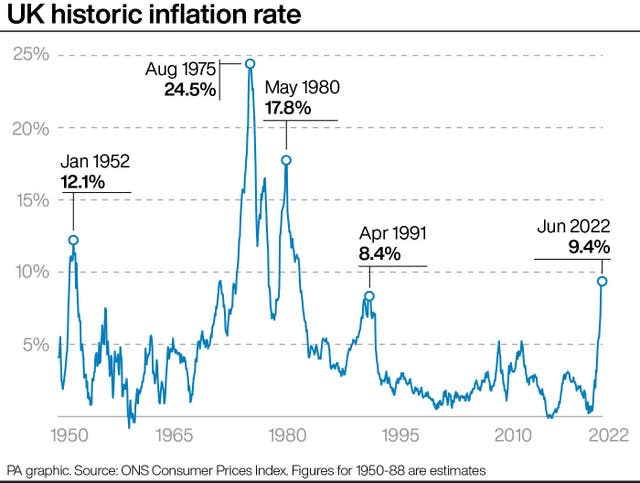What can households do to cope with soaring inflation?
The surging cost of living is pushing more and more households towards breaking point as rising food and fuel prices sent inflation to a new 40-year high.
Combined with eye-watering gas and electricity tariff increases, consumers are facing soaring costs at every turn.
What lies ahead and what can be done to mitigate price rises and keep households afloat through the crisis?
– Why is everything more expensive?
Covid-19 has hit global supply chains with a combination of pent-up demand and delays to shipping as factories across the world face lockdowns and worker absences. This has led to prices rising, particularly for raw materials.
Grant Fitzner continued: (2/3) ⬇️ pic.twitter.com/HFjZ9TawAQ
— Office for National Statistics (ONS) (@ONS) July 20, 2022
Food prices have also risen as wages increase, including for HGV drivers due to recent shortages, with thousands of drivers leaving the UK to return to their home countries in the EU.
Pressure on food and energy prices is being exacerbated as the full impact of Russia’s invasion of Ukraine and the sanctions against President Vladimir Putin’s regime unfold.
The UN Food and Agriculture Organisation has projected that the conflict will lead to a rise in global food prices in 2022 of between 8% and 22%.
– Will inflation remain high?
The peak in inflation is still some way off, and is not expected to return to the 2% target before mid-2024.

This means more pain is on the way for household budgets as the high rate of inflation continues to outpace wage growth, bringing down the real value of incomes across the UK.
– Will energy bills get higher and what can I do to cope with them?
Experts at Cornwall Insight said bills could rise from a current record of £1,971 to £3,245 in October and then further to £3,364 at the start of next year.
The forecasts are based on what an average household will spend on gas and electricity in a year. A household that buys more energy could see higher bills.
Generally, households are encouraged to aim towards building up a credit balance with their supplier to offset higher prices in winter, although there is widespread concern that the increase in Ofgem’s price cap in October will stretch many households beyond what they can afford. The best option now is to ensure homes are insulated and as energy efficient as possible. The only real way to cut energy costs is to use as little as possible in the first place.
– What about food, and how can I reduce the cost of my grocery basket?
Britons are being hit by sharply higher grocery bills, with food and non-alcoholic drink prices having risen by 9.8% in the year to June 2022 – the highest rate since March 2009.
Food prices lifted 1.2% month on month in June, which follows similar increases in April and May as higher cost pressures and the impact of the Ukraine war filter down to the supermarket shelves.

Grocery price inflation is seeing more shoppers turning to cheaper products and supermarket own-brand labels, while customers are also making fewer trips to stores to save on petrol costs, Kantar said.
Consumers are advised to think about shopping for own-brand or value grocery products and set a strict, affordable supermarket budget. Supermarket loyalty schemes can help with making savings.
Cashback sites, and their welcome offers, can be another way of making household budgets stretch further.
– What Government help is coming?
A first instalment of £326 has been paid out to low-income households on benefits from July 14, with a second payment of £324 to follow in the autumn.
The Department for Work and Pensions and HM Revenue and Customs (HMRC) have been identifying those eligible to receive a cost-of-living payment.
Many people will receive the first instalment between July 14 and 31, although for those receiving tax credits, the first payment is to be made from the autumn and the second from winter 2022.
Pensioner households will also receive an extra £300 to help cover the rising cost of energy this winter, while people on disability benefits will receive an extra £150 payment in September.
From October, households will also have £400 taken off energy bills.

People may also see an income boost in their pay packets, as national insurance (NI) starting thresholds increased from £9,880 to £12,570 from July 6.
However, this was after a 1.25 percentage point increase in NI in April, to help pay for health and social care.
– What else can I do to avoid the pinch?
There is no way around it – households need to start thinking very carefully about their spending across the board to counter those price rises they cannot control such as energy and fuel.
A quick look over the monthly bank statement should be a good start.
Always shop around and use comparison sites for phone, broadband and insurance rather than just rolling over into the next year to keep charges and premiums at a minimum.
Consider whether subscriptions are still useful and providing a good deal – many people signed up to new services such as Spotify, Netflix or Sky during lockdown and may no longer use them as much.
The Government-backed MoneyHelper service has budgeting guides at www.moneyhelper.org.uk/en/everyday-money/budgeting

 Yahoo Finance
Yahoo Finance 